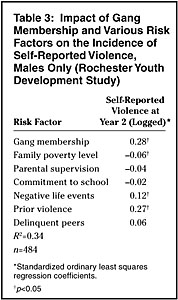|
Rochester Youth Development Project - Results
Figure 6 shows the comparison of male gang members with nonmembers in terms of the frequency of general delinquency, violent delinquency, drug selling, and drug use. Among those who were not gang members, offense rates for all four types of offenses were higher for the respondents who scored higher on the delinquent peer associations scale. More important, however, was the finding that respondents who were gang members always had the highest rates of offending. The results of the comparison of offense rates of gang members and nonmembers with delinquent peers in Rochester provide a strikingly similar picture to those obtained with the Seattle data. Although associating with delinquent peers is related to offense rates, being a member of a gang facilitates delinquency over and above that effect. For violent delinquency among male respondents, for example, there is an increase in the level of offending across the four categories of nonmembers -- from 0.2 for those with few delinquent peers to 2.2 for those who have the highest level of association with delinquent peers. However, the mean for gang members (4.9) is more than twice as high. This rate is significantly different from the rate for nonmembers in the highest quartile of delinquent peers. This finding is particularly important because nonmembers in the highest quartile of involvement with delinquent peers associate with delinquent peers as much as gang members do. This pattern is also observed for general delinquency, drug selling, and drug use. Figure 7 examines the same relationships for female respondents. Female involvement in delinquency and drugs was lower than male involvement; as a result, the patterns are somewhat less consistent, especially for nonmembers. The most important comparison, however, is between female gang members and nonmembers in the highest quartile. In all cases, gang members reported significantly higher involvement as compared with nonmembers. There is a particularly striking effect for drug selling -- among female respondents, only gang members sold drugs.
The results in table 3 indicate that even when the variables listed above are held constant, gang membership still exerts a strong impact on the incidence of violent behavior. The standardized coefficient for gang membership is0.28, approximately the same magnitude of coefficients observed for previous violence (0.27). Indeed, gang membership has the greatest impact on violent behavior of any of the variables included in the equation. 2
2 More detailed information on these results can be found in Thornberry (1998) and Krohn and Thornberry (in press). In the latter report, more refined measures of highly delinquent peer groups (e.g., using deciles rather than quartiles) generate results a little more muted than those reported here.
| ||||
 As with the earlier Seattle analysis, this analysis does not control for the impact of association with delinquent peers. The earlier analysis of the Seattle data controlled for the effect of delinquent peers in examining the impact of gang membership on violent delinquency. To provide a more rigorous examination of whether gang membership has an effect on offense rates, the RYDS controlled for five additional risk factors that covered the domains of family (poverty level and parental supervision), school, stress, and prior delinquency. These additional variables test the possibility that rates of violence are high for gang members not because of a gang effect, but because of the accumulation of risk in their backgrounds. That is, it may not be gang membership that brings about the higher rates of violence; it may instead be other risk factors that are related to gang membership and to delinquency. The variables that were held constant here include family poverty level, parental supervision, commitment to school, negative life events, previous involvement in violence, and association with delinquent peers. The risk factors were measured at the interview prior to the year of gang membership. The analysis is limited to males because of the relatively small number of female gang members.
As with the earlier Seattle analysis, this analysis does not control for the impact of association with delinquent peers. The earlier analysis of the Seattle data controlled for the effect of delinquent peers in examining the impact of gang membership on violent delinquency. To provide a more rigorous examination of whether gang membership has an effect on offense rates, the RYDS controlled for five additional risk factors that covered the domains of family (poverty level and parental supervision), school, stress, and prior delinquency. These additional variables test the possibility that rates of violence are high for gang members not because of a gang effect, but because of the accumulation of risk in their backgrounds. That is, it may not be gang membership that brings about the higher rates of violence; it may instead be other risk factors that are related to gang membership and to delinquency. The variables that were held constant here include family poverty level, parental supervision, commitment to school, negative life events, previous involvement in violence, and association with delinquent peers. The risk factors were measured at the interview prior to the year of gang membership. The analysis is limited to males because of the relatively small number of female gang members.